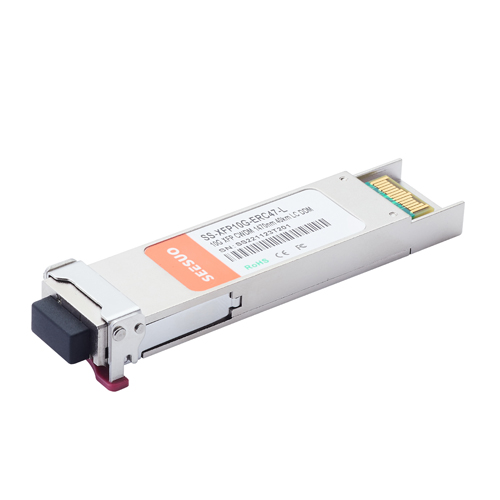- Related articles
- How to Choose an Internal Network Card?
- All Cisco SFP-OC12-SR's information (List price, Specs, Datasheet PDF, Compatibility matri
- All Cisco SFP-10G-LR-S's information (List price, Specs, Datasheet PDF, Compatibility matr
- Optical Transceivers for Cisco SG500-52-K9-G5 Switch
- Optical Transceivers for Cisco N3K-C3172PQ-10GE= Switch
- Optical Transceivers for Cisco IE-2000-4TS-L Switch
- All Cisco CWDM-SFP-1550's information (List price, Specs, Datasheet PDF, Compatibility mat
- How to Find What Ethernet Controller Card I'm using?
- Cisco XFP vs. SFP vs. SFP+
- All Cisco DS-CWDM4G1550's information (List price, Specs, Datasheet PDF, Compatibility mat

Definition of XFP Transceivers
The XFP (10 Gigabit Small Form Factor Pluggable) is a standard for transceivers for high-speed computer network and telecommunication links that use optical fiber. It was defined by an industry group in 2002, along with its interface to other electrical components, which is called XFP transceiver.

XFP transceivers are hot-swappable and protocol-independent. They typically operate at near-infrared wavelengths (colors) of 850 nm, 1310 nm or 1550 nm. Principal applications include 10 Gigabit Ethernet, 10 Gbit/s Fibre Channel, synchronous optical networking (SONET) at OC-192 rates, synchronous optical networking STM-64, 10 Gbit/s Optical Transport Network (OTN) OTU-2, and parallel optics links. They can operate over a single wavelength or use dense wavelength-division multiplexing techniques. They include digital diagnostics that provide management that were added to the SFF-8472 standard. XFP transceivers use an LC fiber connector type to achieve higher density.
The XFP transceiver specification was developed by the XFP Multi Source Agreement Group. It is an informal agreement of an industry group, not officially endorsed by any standards body. The first preliminary specification was published on March 27, 2002. The first public release was on July 19, 2002. It was adopted on March 3, 2003, and updated with minor updates through August 31, 2005. The chair of the XFP group was Robert Snively of Brocade Communications Systems, and technical editor was Ali Ghiasi of Broadcom.The organization's web site was maintained until 2009.
The XFP transceiver electrical interface specification was a 10 gigabit per second chip-to-chip electrical interface specification defined as part of the XFP transceiver multi-source agreement. It was also developed by the XFP MSA group. XFP transceiver provides a single lane running at 10.3125 Gbit/s when using a 64B/66B encoding scheme. A serializer/deserializer is often used to convert from a wider interface such as XAUI that has four lanes running at 3.125 Gbit/s using 8B/10B encoding. XFI is sometimes pronounced as "X" "F" "I" and other times as "ziffie".
The physical dimensions of the XFP transceiver are slightly larger than the original small form-factor pluggable transceiver (SFP). One of the reasons for the increase in size is to allow for on-board heat sinks for more cooling.XFP transceivers are available with a variety of transmitter and receiver types, allowing users to select the appropriate transceiver for each link to provide the required optical reach over the available optical fiber type (e.g. multi-mode fiber or single-mode fiber). XFP modules are commonly available in several different categories:
- SR - 850 nm, for a maximum of 300 m
- LR - 1310 nm, for distances up to 10 km
- ER - 1550 nm, for distances up to 40 km
- ZR - 1550 nm, for distances up to 80 km
Cozlink is a manufacturer and supplier who offer optical modules with low price. A full range of optical transceivers, such as SFP Transceiver, SFP+ Transceiver, XFP Transceiver, X2 Transceiver, GBIC Transceiver, CSFP Transceiver, XENPAK Transceiver and QSFP+ Transceiver. All our fiber transceivers are 100% compatible with major brands like Cisco, HP, Juniper, Nortel, Force10, D-link, 3Com.We can also provide customized services of optical modules and customers can customize LOGO. For any questions, please feel free to contact us.
Please click to check more related concepts
| Transceivers Package | Ethernet standard | Application |
| SFP(small form factor pluggable) | 100Base-FX | Ethernet |
| SFP+ | 1000Base-X | SONET |
| XFP | ||
| QSFP+ | 10GBASE-SR | |
| X2 | ||
| CFP | ||
| Transceivers Wavelength | Fiber mode | Transceiver Terminology |
| Bidi | Single-mode | |
| Multi-mode | ||
| EX | ||
| Cloud | ||
| 802.3 Standard | ||
| SFP ports | ||
| Laser Diode | ||
| Dark fiber | ||
| GPON | ||
| EPON | ||
| IEEE 802.3 | ||
| Linux PAM module | ||
| Opto Electronics | ||
| PAM | ||
| PON |





















































